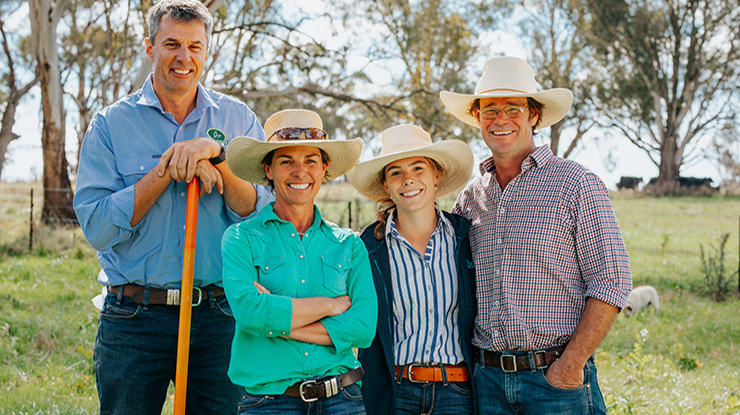 Above: Ben Nevis' agronomist Gary Littlejohns with Erica, Maggie and Stuart Halliday.
Above: Ben Nevis' agronomist Gary Littlejohns with Erica, Maggie and Stuart Halliday.
Putting down the roots of resilience
Fifth generation stud cattle producers Erica and Stuart Halliday are weathering extremes and improving their resilience and productivity by focusing on soil health and changing their grazing management system.
The Hallidays own and operate ‘Ben Nevis Angus’ in the high, cold country of Walcha, NSW, supplying yearling bulls throughout Australia and New Zealand.
The repercussions of a devastating drought – with two-and-a-half years of fallow and depletion of the farm’s topsoil – was the catalyst to switching their grazing management regime.
“What we saw during the drought was our existing grazing system reaching its limits, with escalating input costs delivering ever reducing returns,” Erica said.
“It was a high-input system set up for maximum animal production performance, but it proved fallible to extreme climatic conditions.”
Think outside the box
The Hallidays’ realisation they had to do something different set them on a mission to improve their soils and pastures by building up the soil’s organic matter and microbe load.
On the advice of their agronomist, Garry Littlejohns from AMPS, Stuart and Erica experimented growing multi-species cover crops, including grasses, legumes and deep tap-rooted plant species to promote pasture recovery.
These deep-rooted pastures benefit soil health and fertility, as their roots and tubers break through compacted ground and promote fungi regrowth, providing access to nutrients deep below the surface.
Rye corn in winter and sunflowers in spring help roots go down and break up the soil, with deep-rooted ryegrass also proving to be a useful perennial plant.
As a result, the Hallidays have eliminated tillage and rely on the plants to do the work of breaking up soil and improving filtration and aeration.
Rotational grazing has become an important part of their grazing management. They graze paddocks intensively followed by rest periods to support ground cover and allow pasture to reseed and regenerate.
The Hallidays practice time-control grazing where the period of rest changes depending on the growth phase of the plant which varies through the seasons.
“We’re determined to leave the land in a better state than when we got it,” Erica said.
“We’re continuing to invest in regenerating our soils and soil microbes underground to feed our pastures, and we’re further supporting biodiversity through wildlife corridors.”
Multiple benefits
The results have been dramatic and include:
- a significant reduction in input costs
- fewer metabolic and husbandry issues
- higher weaning weights
- higher live weight gains.
As a cattle veterinarian as well as a producer, Stuart is especially pleased with the unexpected health benefits from cattle grazing this new, multi-species pasture.
“From a health perspective, we didn’t have to put any more inputs into the system which we would normally do – we’re seeing less metabolic issues,” he said.
The productivity figures also stack up, with cattle gaining 200g/head/day more on the multi-species cover crops compared to grazing forage oats.
Future focus
The Hallidays believe that by switching their grazing management regime they’re building their business to become more drought resilient.
Through their commitment to embrace more opportunities to sequester carbon, they hope to become carbon neutral by 2030.
They’re at the beginning of the carbon accounting journey and are working with Landcare to pilot and benchmark their management practices.
“Grazing is integral to our carbon neutral goals as we see cattle as a critical part of the system because they’re part of a natural carbon cycling system,” Erica said.
“Reducing carbon emissions and improving soil carbon is really important for us and we’re so excited to know that beef can be part of the solution to climate change,” Erica said.
The Hallidays’ advice for other producers is to seek out knowledge and answers. In their case, they’re actively involved in their local regenerative agriculture group, Walcha Carbon Group, and utilise the research, tools and producer programs available through MLA.



